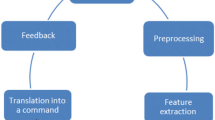Abstract
Interpreting brain waves can be so important and useful in many ways. Having more control on your devices, helping disabled people, or just getting personalized systems that depend on your mood are only some examples of what it can be used for. An important issue in designing a brain-computer interface (BCI) is interpreting the signals. There are many different mental tasks to be considered. In this paper we focus on interpreting left, right, foot and tongue imagery tasks. We use Empirical Mode Decomposition (EMD) for feature extraction and Support Vector Machine (SVM) with Radial Basis Function (RBF) kernel for classification. We evaluate our system on the dataset 2a from BCI competition IV, and very promising classification accuracy that reached 100% is obtained.
Access this chapter
Tax calculation will be finalised at checkout
Purchases are for personal use only
Preview
Unable to display preview. Download preview PDF.
Similar content being viewed by others
References
Grabianowski (ed.): How brain-computer interfaces work (November 2007)
Leeb, R., Friedman, D., Müller-Putz, G.R., Scherer, R., Slater, M., Pfurtscheller, G.: Self-paced (asynchronous) bci control of a wheelchair in virtual environments: a case study with a tetraplegics. In: Computational Intelligence and Neuroscience, p. 79642 (2007)
Scherer, R., Lee, F., Schlogl, A., Leeb, R., Bischof, H., Pfurtscheller, G.: Eeg-based interaction with virtual worlds: A self-paced three class brain-computer interface. In: Computational Intelligence and Neuroscience (2007)
Plant, K.A., Ponnapalli, P.V.S., Southall, D.M.: Mobile robots and eeg - a review. In: SGAI Conf., pp. 363–368 (2007)
Satti, A.R., Coyle, D., Prasad, G.: Self-paced brain-controlled wheelchair methodology with shared and automated assistive control. In: IEEE Symposium on Computational Intelligence, Cognitive Algorithms, Mind, and Brain (2011)
Huang, N.E., Shen, Z., Long, S.R., Wu, M.C., Shih, H.H., Zheng, Q., Yen, N.C., Tung, C.C., Liu, H.H.: The empirical mode decomposition and the Hilbert spectrum for nonlinear and non-stationary time series analysis. Proceedings of the Royal Society of London. Series A: Mathematical, Physical and Engineering Sciences 454, 903–995 (1971)
Osuna, E., Freund, R., Girosi, F.: Support vector machines: Training and applications. Technical report, Cambridge, MA, USA (1997)
Wang, J., Xu, G., Wang, L., Zhang, H.: Feature extraction of brain-computer interface based on improved multivariate adaptive autoregressive models. In: 2010 3rd International Conference on Biomedical Engineering and Informatics (BMEI), vol. 2, pp. 895–898 (October 2010)
Herman, P., Prasad, G., McGinnity, T.M., Coyle, D.: Comparative analysis of spectral approaches to feature extraction for eeg-based motor imagery classification. IEEE Transactions on Neural Systems and Rehabilitation Engineering 16(4), 317–326 (2008)
Jangraw, D.C., Sajda, P.: Feature selection for gaze, pupillary, and eeg signals evoked in a 3d environment. In: Proceedings of the 6th Workshop on Eye Gaze in Intelligent Human Machine Interaction: Gaze in Multimodal Interaction, GazeIn 2013, pp. 45–50. ACM, New York (2013)
Hosni, S.M., Gadallah, M.E., Bahgat, S.F., AbdelWahab, M.S.: Classification of eeg signals using different feature extraction techniques for mental-task bci. In: International Conference on Computer Engineering Systems, ICCES 2007, pp. 220–226 (2007)
Suleiman, A.-B.R., Fatehi, T.A.-H.: Features extraction techniques of eeg signal for bci applications, p. 5 (2011)
Liang, H., Bressler, S.L., Desimone, R., Fries, P.: Empirical mode decomposition: a method for analyzing neural data. Neurocomputing 65-66, 801–807 (2005)
Wang, J., Xu, G., Wang, J., Yang, S., Yan, W.: Application of hilbert-huang transform for the study of motor imagery tasks. In: 30th Annual International Conference of the IEEE Engineering in Medicine and Biology Society, EMBS 2008, pp. 3848–3851 (2008)
Demir, B., Erturk, S., Gullu, M.K.: Hyperspectral image classification using denoising of intrinsic mode functions. IEEE Geoscience and Remote Sensing Letters 8(2), 220–224 (2011)
Weng, B., Barner, K.: Optimal signal reconstruction using the empirical mode decomposition. EURASIP Journal on Advances in Signal Processing 2008(1), 845294 (2008)
Lotte, F., Congedo, M., Lécuyer, A., Lamarche, F., Arnaldi, B.: A review of classification algorithms for eeg-based brain-computer interfaces. Journal of Neural Engineering 4(2), R1–R13 (2007)
Lambert, M., Engroff, A., Dyer, M., Byer, B.: Empirical mode decomposition (December 2002)
Rutkowski, T.M., Mandic, D.P., Cichocki, A., Przybyszewski, A.W.: Emd approach to multichannel eeg data - the amplitude and phase synchrony analysis technique. In: Huang, D.-S., Wunsch II, D.C., Levine, D.S., Jo, K.-H. (eds.) ICIC 2008. LNCS, vol. 5226, pp. 122–129. Springer, Heidelberg (2008)
Brunner, C., Leeb, R., Müller-Putz, G., Schlögl, A., Pfurtscheller, G.: BCI Competition - Graz data set A (2008)
Author information
Authors and Affiliations
Editor information
Editors and Affiliations
Rights and permissions
Copyright information
© 2014 Springer International Publishing Switzerland
About this paper
Cite this paper
El-Kafrawy, N.M., Hegazy, D., Tolba, M.F. (2014). Features Extraction and Classification of EEG Signals Using Empirical Mode Decomposition and Support Vector Machine. In: Hassanien, A.E., Tolba, M.F., Taher Azar, A. (eds) Advanced Machine Learning Technologies and Applications. AMLTA 2014. Communications in Computer and Information Science, vol 488. Springer, Cham. https://doi.org/10.1007/978-3-319-13461-1_19
Download citation
DOI: https://doi.org/10.1007/978-3-319-13461-1_19
Publisher Name: Springer, Cham
Print ISBN: 978-3-319-13460-4
Online ISBN: 978-3-319-13461-1
eBook Packages: Computer ScienceComputer Science (R0)




